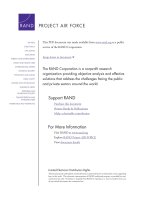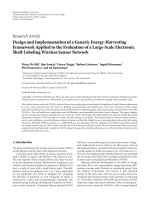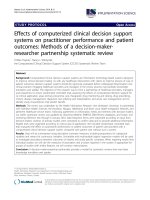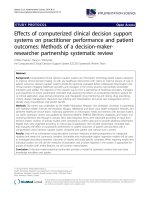New and emerging methods of bridge strengthening and repair and development of a bridge rehabilitation website framework
Bạn đang xem bản rút gọn của tài liệu. Xem và tải ngay bản đầy đủ của tài liệu tại đây (4.68 MB, 227 trang )
NEW AND EMERGING METHODS OF
BRIDGE STRENGTHENING AND REPAIR
AND DEVELOPMENT OF
A BRIDGE REHABILITATION WEBSITE FRAMEWORK
by
Tiera Rollins
A thesis submitted to the Faculty of the University of Delaware in partial
fulfillment of the requirements for the degree of Master of Civil Engineering
Fall 2015
© 2015 Tiera Rollins
All Rights Reserved
ProQuest Number: 10014933
All rights reserved
INFORMATION TO ALL USERS
The quality of this reproduction is dependent upon the quality of the copy submitted.
In the unlikely event that the author did not send a complete manuscript
and there are missing pages, these will be noted. Also, if material had to be removed,
a note will indicate the deletion.
ProQuest 10014933
Published by ProQuest LLC (2016). Copyright of the Dissertation is held by the Author.
All rights reserved.
This work is protected against unauthorized copying under Title 17, United States Code
Microform Edition © ProQuest LLC.
ProQuest LLC.
789 East Eisenhower Parkway
P.O. Box 1346
Ann Arbor, MI 48106 - 1346
NEW AND EMERGING METHODS OF
BRIDGE STRENGTHENING AND REPAIR
AND DEVELOPMENT OF
A BRIDGE REHABILITATION WEBSITE FRAMEWORK
by
Tiera Rollins
Approved:
__________________________________________________________
Michael J. Chajes, Ph.D.
Professor in charge of thesis on behalf of the Advisory Committee
Approved:
__________________________________________________________
Harry W. Shenton III, Ph.D.
Chair of the Department of Civil & Environmental Engineering
Approved:
__________________________________________________________
Babatunde A. Ogunnaike, Ph.D.
Dean of the College of Engineering
Approved:
__________________________________________________________
Ann L. Ardis, Ph.D.
Interim Vice Provost for Graduate & Professional Education
ACKNOWLEDGMENTS
I would like to thank my advisor, Dr. Michael Chajes, whose patience,
guidance, and encouragement always inspired me and helped me to keep a focused
perspective instead of letting my worry get out of control. He trusted in my ability to
do things I hadn’t before, and I have learned so much. Thank you.
I would like to thank the Federal Highway Administration for their support,
interest, and funding in this project.
I would like to thank my amazing husband, Philip, who always knew what I
needed, whether it was a break from research, or a few quiet hours for writing, and
was always ready and willing to help. He was my rock and my foundation all through
school, offering constant support and encouragement. I would like to thank my son,
Jack, who can always make me laugh. I would like to thank my parents and the rest
of my family for their support and encouragement. I would like to thank my mom
especially, for always being there to answer the phone when I needed to vent, and to
be there for me to tell her I finished writing!
I would also like to thank Sue Pratt for watching Jack while I went to class,
worked on research, and wrote my thesis. He loved spending time at her house,
learning to color and paint, and playing with her sons. Knowing that he was in good
hands allowed me to focus and work productively.
These people helped me in so many ways to make this thesis possible. Thank
you all from the bottom of my heart.
iii
TABLE OF CONTENTS
LIST OF TABLES .......................................................................................................viii
LIST OF FIGURES ....................................................................................................... ix
ABSTRACT................................................................................................................... xi
Chapter
1
INTRODUCTION .............................................................................................. 1
1.1
1.2
1.3
1.4
2
Research Problem Statement ..................................................................... 1
Research Objectives ................................................................................... 1
Scope of Investigation ............................................................................... 2
Research Approach .................................................................................... 2
LITERATURE REVIEW: LABORATORY RESEARCH CONCERNING
BRIDGE STRENGTHENING ........................................................................... 4
2.1
2.2
2.3
Literature Review Overview ...................................................................... 4
Composite Material Overview ................................................................... 5
New Bridge Strengthening Methods: Backgrounds and Definitions......... 7
2.3.1
2.3.2
2.3.3
2.3.4
2.3.5
2.3.6
2.4
Externally bonded FRP .................................................................. 7
Mechanically fastened FRP ........................................................... 8
Near surface mounting composites ................................................ 9
Post-tensioning composites............................................................ 9
Fiber reinforced cementitious matrix as a strengthening
system .......................................................................................... 10
Spray FRP as a strengthening system .......................................... 10
Experimental Research of New Bridge Strengthening Methods ............. 11
2.4.1
2.4.2
2.4.3
2.4.4
2.4.5
Anchorage systems for EB and MF composite retrofits .............. 11
Near surface mounting composite strengthening systems ........... 15
Post-tensioning composite systems ............................................. 21
Fiber reinforced cementitious matrix as a strengthening
system .......................................................................................... 23
Spray FRP as a strengthening material ........................................ 26
iv
2.5
Experimental Research of Unique Types of Strengthening..................... 28
2.5.1
2.5.2
Impact damaged overpass girders repaired with composites....... 28
Fatigue damage repair of steel structures .................................... 29
2.5.2.1
2.5.2.2
Laboratory studies of steel fatigue damage repair ........ 29
Finite element modeling of steel fatigue damage
repair ............................................................................. 30
2.5.2.3 Implemented steel fatigue damage repair ..................... 31
2.5.3
2.5.4
2.5.5
2.6
Research of Alternate Applications of Composite Materials .................. 37
2.6.1
2.6.2
2.6.3
2.6.4
2.6.5
2.7
Column retrofitting with composites ........................................... 32
Strengthening arch structures with composites ........................... 35
Strengthening torsional members of structures with
composites ................................................................................... 36
FRP beams as load bearing members .......................................... 37
Bridge-in-a-backpack: concrete-filled FRP tube arch bridge
construction .................................................................................. 42
Steel buckling reinforcement with composites ............................ 44
Efforts to improve composite material properties and behavior.. 45
Vacuum assisted resin transfer molding ...................................... 47
Miscellaneous Research Topics of Interest ............................................. 48
2.7.1
2.7.2
2.7.3
2.7.4
2.7.5
Measuring bridge strength ........................................................... 49
Fatigue performance of structures strengthened with
composites ................................................................................... 51
Effect of load on FRP repairs ...................................................... 52
Unusual bridge geometries .......................................................... 53
Modifying bridge structure .......................................................... 54
2.7.5.1
Converting a continuous multi-span bridge to a
network arch bridge ...................................................... 54
2.7.5.2 Converting non-integral abutments to integral
abutments ...................................................................... 55
3
LITERATURE REVIEW: FIELD IMPLEMENTATIONS AND LESSONS
LEARNED ........................................................................................................ 58
3.1
3.2
3.3
Innovative Bridge Research and Construction Program Overview ......... 58
Survey Results ......................................................................................... 59
Bridge Strengthening by Category .......................................................... 64
v
3.3.1
Flexural Strengthening with Composites..................................... 64
3.3.1.1
3.3.1.2
3.3.1.3
3.3.1.4
Concrete beams strengthened with composites ............ 65
Timber beams strengthened with composites ............... 68
Steel beams strengthened with composites ................... 69
Summary of findings regarding flexural
strengthening with composites...................................... 70
3.3.1.5 Field implemented flexural strengthening with
composites .................................................................... 71
3.3.1.5.1
3.3.2
Innovative Bridge Research and
Construction Program: flexural
strengthening results ................................... 75
Shear Strengthening with Composites ......................................... 79
3.3.2.1
Laboratory testing experimental results of shear
strengthening ................................................................. 79
3.3.2.2 Field implemented shear strengthening with
composites .................................................................... 85
3.3.2.2.1
3.3.3
Increasing Live Load Capacity with Lightweight Composite
Decks and Deck Strengthening with Composites ........................ 89
3.3.3.1
Field implemented lightweight composite decks and
deck strengthening with composites ............................. 92
3.3.3.1.1
3.3.3.2
3.3.3.3
3.4
Innovative Bridge Research and
Construction Program: shear
strengthening results ................................... 88
Innovative Bridge Research and
Construction Program and other
implementations: lightweight deck results . 96
Ongoing research on lightweight composite decks .... 103
Research to increase the durability of bridge decks ... 105
Specifications and Guidelines ................................................................ 111
3.4.1
3.4.2
3.4.3
3.4.4
FRP Decks ................................................................................. 111
Shear Strengthening with FRPs ................................................. 112
Flexural Strengthening with FRPs ............................................. 114
List of Guidelines and Specifications ........................................ 116
vi
4
FRAMEWORK FOR BRIDGE REHABILITATION WEBSITE ................. 118
4.1
4.2
4.3
4.4
4.5
4.6
4.7
5
BRIDGE STRENGTHENING DESIGN EXAMPLES ................................. 153
5.1
5.2
6
Background and Set-Up ......................................................................... 118
Home Page ............................................................................................. 120
Catalog of Technologies ........................................................................ 121
Technology Selection ............................................................................ 123
Resources ............................................................................................... 124
Contribute .............................................................................................. 126
Website Pages ........................................................................................ 128
Design Examples ................................................................................... 153
General Format for Bridge Strengthening Design Examples ................ 154
SUMMARY .................................................................................................... 157
6.1
6.2
6.3
6.4
6.5
Review of Research Objectives ............................................................. 157
Literature Review Summary .................................................................. 157
Website Framework: Potential and Summary ....................................... 159
Design Examples Summary ................................................................... 161
Recommendations for Future Work ...................................................... 161
REFERENCES ........................................................................................................... 163
Appendix
A
MISCELLANEOUS LISTS AND INFORMATION ..................................... 188
A.1 Traditional Bridge Strengthening Methods ........................................... 188
A.2 Survey Questions ................................................................................... 189
B
WEBSITE PDFs ............................................................................................. 190
B.1 Technology Fact Sheet........................................................................... 191
B.2 Example Case Study .............................................................................. 193
B.3 Design Example: Flexural strengthening of a concrete T-beam in an
unstressed condition with FRP composites ........................................... 195
C
PERMISSION LETTERS .............................................................................. 213
vii
LIST OF TABLES
Table 1. IBRC Projects using FRP Beams ................................................................... 39
Table 2. IBRC Projects using Structural Health Monitoring Systems ......................... 50
Table 3. Summary of IBRC Projects by Category........................................................ 59
Table 4. Instances of Bridge Flexural Strengthening with FRP Composites ............... 72
Table 5. FRP Strengthening of Bridge Members in IBRC Projects ............................. 76
Table 6. Instances of Bridge Shear Strengthening with FRP Composites.................... 86
Table 7. Instances of Lightweight FRP Decks and Bridge Deck Strengthening with
FRP Composites ...................................................................................... 93
Table 8. IBRC Projects using FRP Decks .................................................................... 98
Table 9. IBRC Projects using MMFX reinforcing bars .............................................. 109
viii
LIST OF FIGURES
Figure 1. Illustration of various FRP NSM reinforcements........................................ 20
Figure 2. FRP Arches being lowered into place ......................................................... 42
Figure 3. Sheet metal installed on FRP tubes ............................................................. 43
Figure 4. Completed Neal Bridge ............................................................................... 44
Figure 5. Conversion of continuous multi-span bridge to network arch bridge ......... 55
Figure 6. Simplified geometry of an integral abutment bridge................................... 56
Figure 7. Locations of U.S. Survey Responses........................................................... 60
Figure 8. Survey Question 1 Responses ..................................................................... 61
Figure 9. Survey Question 3 Responses ..................................................................... 62
Figure 10. Honeycomb sandwich configuration ........................................................... 90
Figure 11. Solid core sandwich configuration .............................................................. 90
Figure 12. Pultruded hollow core sandwich configuration ........................................... 91
Figure 13. Strengthening Scheme: Cross-Sectional View. (a) Side bonding, (b) Uwrap, and (c) Complete wrap................................................................. 113
Figure 14. Strengthening Scheme: Side View – (a) Fibers at 90° direction, and (b)
Fibers at Inclined Direction ................................................................... 113
Figure 15. Bridge Rehabilitation Website Flow Chart ............................................... 120
Figure 16. Website Home Page .................................................................................. 128
Figure 17. Home Page: Catalog of Technologies Tab in Navigation Bar .................. 129
Figure 18. Catalog of Technologies Main Page ......................................................... 130
Figure 19. Catalog of Technologies Drop-down Menus ............................................ 131
ix
Figure 20. Catalog of Technologies: Select a Technology ......................................... 132
Figure 21. Catalog of Technologies: Technology Information Page.......................... 133
Figure 22. Catalog of Technologies: PDF Selection .................................................. 134
Figure 23. Technology Information PDFs: Technology Fact Sheet ........................... 135
Figure 24. Technology Information PDFs: Photos ..................................................... 136
Figure 25. Technology Information PDFs: Case Study.............................................. 137
Figure 26. Technology Information PDFs: Design Example ..................................... 138
Figure 27. Technology Information PDFs: Bibliography........................................... 139
Figure 28. Technology Information PDFs: Bibliography-Reference Matrix ............. 140
Figure 29. Home Page: Technology Selection Tab .................................................... 141
Figure 30. Technology Selection Main Page .............................................................. 142
Figure 31. Technology Selection: Choose a Matrix Option ....................................... 143
Figure 32. Technology Selection: List of Applicable Technologies .......................... 144
Figure 33. Home Page: Resources Tab and Drop-down Menu .................................. 145
Figure 34. Resources: Case Studies ............................................................................ 146
Figure 35. Resources: Glossary .................................................................................. 147
Figure 36. Resources: Abbreviations .......................................................................... 147
Figure 37. Resources: Frequently Asked Questions ................................................... 148
Figure 38. Home Page: Contribute Tab and Drop-down Menu ................................. 149
Figure 39. Contribute: Submit Technology-Specific Information Page ..................... 150
Figure 40. Contribute: Case Study Submittal Template ............................................. 151
Figure 41. Contribute: Submit a Comment................................................................. 152
x
ABSTRACT
The purpose of this thesis is to document state-of-the-art methods for bridge
strengthening and to develop a framework for a bridge rehabilitation website that will
be a repository for information on new strengthening methods and will make this
information available along with information on traditional strengthening methods.
The last comprehensive state-of-the-art report on bridge strengthening was published
in 1997. Through an in-depth literature review, new and emerging methods of bridge
repair developed since 1997 are presented. Based on the current bridge strengthening
and repair methods, a framework for a bridge rehabilitation website is created which
enables bridge owners and bridge engineers to efficiently select appropriate
rehabilitation methods for their bridges. The website framework presents traditional
and novel repair methods highlighting the applicability of each method depending on
bridge type, and allows the user to access case studies, photo galleries, and design
examples of various repair options. The website framework also allows users to
contribute case studies of their bridge strengthening projects, which will enable the
site to be continually updated.
xi
Chapter 1
INTRODUCTION
1.1
Research Problem Statement
The nation’s population and economy are growing, which puts larger stresses on
the nation’s aging and deteriorating infrastructure. The transportation system built
decades ago needs to be updated in order to support the increase in demand, so bridge
owners and bridge engineers are looking for efficient methods to repair their bridges
and increase their live load capacity. These methods not only need to be cost effective
and quickly implementable, but they also need to produce long term solutions which
will lengthen the service life of the structure. New methods have been and are being
developed to meet these criteria. In order to make information on the new and
emerging technologies more readily available to bridge owners and bridge engineers,
the information needs to be gathered together for easy access.
1.2
Research Objectives
The first research objective is to synthesize a report which details the new
bridge repair methods which have been developed since the last comprehensive bridge
report in 1997 [1]. The second research objective is to create a framework for a
website about traditional and novel bridge repair methods, featuring a decision matrix
which enables bridge owners and bridge engineers to more efficiently select
appropriate repair methods for their bridges.
1
1.3
Scope of Investigation
The new and emerging technologies being used for bridge repair were identified
through an exhaustive literature review, information collected by FHWA as a part of
the Innovative Bridge Research & Construction (IBRC) and Innovative Bridge
Research & Deployment (IBRD) projects, and surveys distributed to members of select
AASHTO, FHWA, and TRB groups and committees.
The website framework consists of a decision matrix, a Technology Submittal
Form template, and a Technology Information page template. The Technology
Information page includes general information, photos, case histories, and a design
example.
1.4
Research Approach
To collect information on new strengthening methods, an exhaustive literature
review was conducted using the databases Web of Science, Compendex (Engineering
Village), ASCE, and TRID. Surveys were sent out to members of different AASHTO,
FHWA, and TRB committees and teams in the spring of 2015. This literature search
was not meant to yield a comprehensive listing of all research and bridge strengthening
projects that have been completed since 1997, but rather provide a representative
sample of the new types of strengthening methods being researched and implemented
in the field. Chapter 2 will present a broad range of research topics related to bridge
strengthening, while Chapter 3 will present representative examples of field
implementations of new bridge strengthening methods and the lessons learned from
those implementations.
To assist in the development of a website framework, other web-based decision
guides were researched and used as models for the framework of the bridge
2
rehabilitation website and design examples found in the literature were investigated and
one particular example was adapted to create a template for the website.
3
Chapter 2
LITERATURE REVIEW: LABORATORY RESEARCH CONCERNING
BRIDGE STRENGTHENING
2.1
Literature Review Overview
Over the last two decades, new methods of strengthening bridges have been
developed in an effort to meet the increasing demands placed on the aging
infrastructure by present day traffic. Since traditional methods of strengthening, listed
in Appendix A.1, are described and expounded upon in previous NCHRP synthesis
Reports 249 (1997) [1] and 293 (1987) [2], this report focuses only on new methods
and variations of traditional methods developed since the 1997 synthesis. Most of the
research and new methods that have been applied in the field according to the literature
review, IBRC reports, and survey results involve composite materials. Findings from
the literature review and IBRC reports will be described throughout this chapter and
Chapter 3. The survey results can be found in Section 3.2.
The literature review conducted included the databases Web of Science,
Compendex, ASCE, and TRID. About 87% of the reports and papers found involved
applications of advanced composite materials (ACM) in the strengthening procedure.
The Innovative Bridge Research and Construction (IBRC) and Innovative Bridge
Research and Deployment (IBRD) Programs were created by FHWA in an effort to
encourage state DOTs to implement new technologies in bridge repair and new bridge
construction. Throughout the remainder of this thesis, these programs will be
referenced collectively as the ‘IBRC program’ or ‘IBRC projects.’ Reports were
collected from the states which detailed lessons learned from their experiences and
4
compiled into a report which remains unpublished at this time [3]. The IBRC reports
were reviewed as part of the literature search for this project. About 85% of the IBRC
repair or strengthening projects involved fiber reinforced polymer (FRP) composites as
the innovative technology.
Composites have been implemented in a variety of strengthening methods
including reducing dead load, strengthening of members, and post-tensioning of
members. An overview of composite materials will be given, followed by backgrounds
and definitions of the new bridge strengthening methods. The remainder of this chapter
will present the laboratory research findings reported in the literature review. While
some research topics covered in this chapter are not bridge strengthening methods, they
were included in order to provide valuable information related to bridge strengthening.
As previously stated, the information presented in this document provides a
representative sample of the research and activities that have been conducted on new
methods of bridge strengthening and is not meant to be an all-inclusive account of
completed projects.
2.2
Composite Material Overview
Composites materials provide great benefits for bridge repair because they have
a high strength-to-weight ratio, which makes them lightweight, and they are durable
because they do not corrode like steel or deteriorate under water exposure like concrete.
Composites are made up of textile fibers in a polymer matrix, thus they are known as
fiber reinforced polymers (FRPs). Fibers most commonly used for structural
applications include carbon (graphite) and E-glass (fiberglass). Some research has been
conducted with Kevlar (aramid) fibers [4]. A study was conducted to compare these
materials and the results showed that all three provide adequate strength, and therefore
5
the limiting factor would be cost of material and the amount of reinforcement required
[5]. The polymer matrix used is commonly an epoxy resin.
The fibers can be oriented in a single direction (unidirectional), or in two or
more directions depending on the application and desired strength. Unidirectional
fibers perform best in tension because they can be aligned with the axial stresses, while
fibers that cross at varying angles perform well in shear. The fibers are most
commonly woven into sheets for structural applications. The fabric sheets can be
applied to the structure in situ, which means irregular geometries can be
accommodated. The segment of the structure in need of repair can be wrapped in the
fabric and then epoxy is applied which will harden and form a bond between the
original structure and the composite. Mechanical fasteners can also be used to install
FRP as an alternative to epoxy bonding. Premade panels can be ordered from a
manufacturer to reduce installation time for flat surfaces. FRP bars are also available
for near surface mounted (NSM) or post-tensioning repairs.
Composites are lightweight, so they are less expensive to transport than steel or
concrete and easier to handle and install (no heavy construction equipment required).
A summary of the applicability of FRP in civil engineering structures is given by Meier
[6]. The advantages of composites in structural strengthening to increase flexural
capacity, and improve shear and impact resistance are outlined by Berry [7]. He
explains that increased legal loads of modern day require many buildings and bridges
built decades ago to be strengthened.
6
2.3
New Bridge Strengthening Methods: Backgrounds and Definitions
This section offers descriptions, advantages and disadvantages of the new
methods which have been developed since the 1997 synthesis report. These methods
include external bonding, mechanical fastening, near surface mounting, and posttensioning of FRPs. Fiber reinforced cementitious matrix and spray FRP as
strengthening systems are also introduced. Research conducted to develop and improve
these methods is covered in Section 2.4.
2.3.1
Externally bonded FRP
External bonding of FRPs involves applying the composite material to the
external face of a structure with a layer of epoxy, so it is also called epoxy bonding in
the literature. This report will use the term externally bonded (EB) FRP. FRPs can be
bonded in the form of strips, plates, sheets, or wraps. For pre-cured composite plates, a
layer of epoxy acts as an adhesive between the plate and the structure, while dry fiber
sheets are applied on site where the epoxy then forms the polymer matrix of the
composite and also acts as the adhesive when it cures. The curing time required for the
epoxy to form the bond between the structure and the FRP composite is a matter of
hours, so traffic closures are minimal. Some research has been conducted to suggest
that the strength of the FRP bond is not affected by traffic loading, so traffic may even
remain open during repairs [8].
Fiber sheets are most commonly applied by hand where the epoxy is spread
with a trowel. Research is ongoing to try to implement vacuum assisted resin transfer
molding (VARTM) in the field. This application method involves sealing the FRP
material to the structure with an air tight covering and creating a vacuum through which
the epoxy is pulled from one end of the repair to the other by a machine. VARTM
7
yields a better, stronger bond due to even and thorough distribution of epoxy (see
Section 2.6.5 for more details).
Externally bonded (EB) FRPs provide an alternate load path for the structure,
which increases the structural capacity. EB FRPs prevent existing cracks from opening
and propagating and prevent future cracks from forming, which restores capacity lost
due to cracking and prolongs the structure’s service life. By controlling the opening of
cracks, the bonded FRP often improves the stiffness of the member as well. EB FRPs
also protect the structure from concrete deterioration and steel corrosion.
FRPs can be bonded to the tension face of concrete, steel, or timber beams to
increase flexural capacity, or to the sides of beams to increase shear capacity. FRP
fabric wraps have also been used to strengthen columns in flexure, shear, and axial
strength, and to provide added impact resistance which will be discussed in Section
2.5.3. Research is ongoing to extend the application of EB FRP to fatigue repair and
strengthening (Section 2.5.2) and strengthening torsional members (Section 2.5.5).
One drawback of EB FRP is that the ends of the FRP are vulnerable to peeling
or delaminating from the structure due to high shear stresses at the end locations, which
results in a loss of strength. Research has been conducted to prevent delaminations
including beveling the edges of pre-cured plates and anchoring the ends of the repair
material. Anchors can include additional strips of composite material applied
transversely across the end of the repair or mechanical fasteners.
2.3.2
Mechanically fastened FRP
In an effort to prevent delamination and ‘peeling’ of FRP repairs, mechanical
fasteners are being used to install FRPs in an increasing number of applications. This
method is referred to as mechanically fastened (MF) FRP. These fasteners include
8
concrete screws, steel powder-actuated fastened (PAF) pins, and steel anchors.
Research has shown that a combined system of externally bonded and mechanically
fastened FRP material provides the most reliable strengthening effect (see Section
2.4.1). The use of mechanical fasteners also allows for easier post-tensioning of the
FRP material, which can increase the amount of strength gained from the retrofit.
2.3.3
Near surface mounting composites
Another method utilized to minimize debonding is near surface mounting. This
method involves cutting a groove in the surface of the beam, applying epoxy, placing
the FRP material, and filling the remaining space with epoxy. “The principle of NSM
reinforcement is to introduce additional reinforcement into the concrete section in such
a way that it acts compositely with the rest of the section in the same way as if it were
cast into the concrete” [9]. The grooves can be cut longitudinally, vertically, or
diagonally on the beam and can vary in length depending on the application. FRP
strips, plates, and both circular and rectangular rods have been near surface mounted.
With this method, three sides of the FRP are bonded to the concrete member, which
minimizes the chance for debonding and increases force transfer. This method also
offers greater protection to the retrofit from environmental impacts. Near surface
mounting provides a significant increase in moment capacity with relatively little repair
material. NSM FRP bars can be prestressed in order to utilize more strength of the
composite.
2.3.4
Post-tensioning composites
Post-tensioning is not a new method, but it can be applied to all of the new
methods listed above. Post-tensioning introduces a tensile axial force in a material,
such as an FRP strip or rod, which is to be installed or attached to a base structure,
9
usually a beam. The force is released after the material is installed, thereby creating a
compressive force in the base structure and possibly a moment if the material was
applied eccentrically to the structure. The induced forces and moments are designed to
counteract the forces and moments caused by the loading on the structure, thereby
increasing the structure’s capacity.
2.3.5
Fiber reinforced cementitious matrix as a strengthening system
Fiber Reinforced Cementitious Matrix (FRCM) “is a composite material
consisting of one or more layers of cement-based matrix reinforced with dry-fiber
fabric” [10]. The dry fiber sheets are placed against the structure being strengthened
and a cement-based mortar is applied with a trowel to form the matrix of the composite
and bond the system to the structure. Fiber reinforced cementitious matrix provides
many benefits over FRP laminates, including a water-based inorganic binder, resistance
to UV radiation, permeability compatibility with concrete, and unvarying workability
between 40 and 105 degrees F [11]. The cement-based mortar is more compatible with
concrete structures than epoxy and produces a stronger bond. Carbon and glass fiber
sheets are mostly used as the reinforcing of FRCM, but steel fiber sheets are also being
researched (see Section 2.4.4).
2.3.6
Spray FRP as a strengthening system
Spray FRP was pioneered at the University of British Columbia and involves
using a spray gun to spray polymer and short, randomly distributed fibers concurrently
on the surface of concrete to be repaired resulting in a 2-dimensional random
distribution of fibers applied to the surface of the structure [12].
10
2.4
Experimental Research of New Bridge Strengthening Methods
Most of the material found in the literature review consisted of experimental
studies on composite materials used to strengthen bridges and other structures. Since
the concept of strengthening civil structures with composite materials is new,
significant research has been, and continues to be, conducted to provide a database of
how the materials perform in different circumstances. The research conducted has
created the needed stepping stones to enable composite repairs to become a more
mainstream technique and to provide a foundation for future field implementation.
The experimental studies presented in this section investigate how to improve
new bridge strengthening methods. Tests were conducted to develop stronger bonds,
better anchorage systems, and optimal material compositions to maximize the benefit of
retrofitting with composite materials. Using a combination of methods simultaneously
to achieve greater increase in structural capacity was also researched in several studies.
2.4.1
Anchorage systems for EB and MF composite retrofits
Initially, FRPs were simply applied to the surface of the beams to restore lost
capacity. However, considerable research and testing has been conducted to improve
the strength gained from composite repairs. One major area of concern and research
has been to prevent bond delamination. Debonding of the composite material from the
concrete substrate is a major concern, as it compromises the effectiveness of the repair.
Various techniques to improve the bond have been researched.
Traditional surface preparation techniques, such as sandblasting, are compared
to an alternative technique of grooving the surface, proposed in reference [13] from
2010. “Surface preparation is typically associated with such constraints as adverse
environmental impacts, economic losses due to stoppage of activities, repair costs, or
even inaccessibility of the member(s) to be strengthened” [13]. A study conducted in
11
2007 on the effect of concrete surface profile on bond strength of FRP reported that
surface roughness achieved with grinding or pressure washing appeared to have no
significant influence on the overall performance or failure mode of the FRP [14].
However, the 2010 study on the effects of grooving beam surfaces reported that
“Results indicated that surface preparation prior to bonding of FRP sheets increased
ultimate rupture strength. It was also found that the substitute preparation methods
greatly compensated for the lack of conventional surface preparation such that they
changed, in some cases, the ultimate failure behavior of the member” [13].
The connection mechanism between the FRP material and the structure has also
been researched at length. Studies have been conducted on mechanically fastened
anchorage systems, which include “steel power actuated fastening “pins” (PAFs), steel
anchor bolts or concrete screws, or a combination thereof,” and a summary of a
decade’s worth of research is given in [15].
A study on RC beams strengthened with Powder-actuated fastened (PAF) FRP
demonstrated that the strengthening system would continue to provide an increase in
flexural strength over the control specimen for several different levels of steel corrosion
[16].
Another study investigated concrete beams strengthened with mechanically
fastened FRP, using concrete screws as the anchor system [17]. The effects of fastener
number, spacing, and pattern were investigated and results showed that this
strengthening method increased the flexural strength of the member by 12-39% with
little or no loss in ductility.
Shear tests were conducted to determine the interfacial behavior between
mechanically fastened (MF) FRP composites and the concrete substrate and an FE
model was developed from the results to predict the interfacial behavior [18].
12
While steel anchors were originally used when prestressed FRP sheets were first
used for rehabilitations, recent research has been conducted on the use of nonmetallic
anchorage systems including non-anchored U-wraps, mechanically anchored U-wraps,
and CFRP sheet-anchored U-wraps [19]. Test results showed that the beams with
nonmetallic anchoring systems had comparable load-carrying capacity to the control
beam with steel anchorage, while the nonmetallic anchoring systems more efficiently
resisted peel-off cracking of the strengthening system.
A 2011 study proposes the use of fiber-reinforced cementitious composite
(FRCC) plates glued on top of FRP sheets to act as an anchorage system [20]. Test
results showed that this anchorage system can improve the ultimate load and central
deflection of strengthened beams compared to beams strengthened without anchors or
those strengthened with conventional U-shaped FRP anchors.
“An effective anchorage system allows externally bonded FRP reinforcements
to continue carrying load, even after debonding occurs” [21]. A study was conducted to
compare three different anchorage systems for shear strengthening of RC T-beams. The
anchorage systems tested were “the so-called (1) discontinuous mechanical anchorage
(DMA) system, (2) sandwich discontinuous mechanical anchorage (SDMA) system,
and (3) additional horizontal strips (HS) system” [21]. “Results showed that the SDMA
system performed best, followed by the DMA and HS systems” [21]. The SDMA
system increased the shear strength of the beams by 59-91% and altered the failure
mode from FRP debonding to FRP rupture. The study also found that the shear
contribution from internal transverse steel reinforcement varied depending on which
anchorage system was used.
Deck strengthening experiments were conducted to compare MF unbonded FRP
and EB FRP with and without end anchorage systems [22]. Results showed that EB
13









